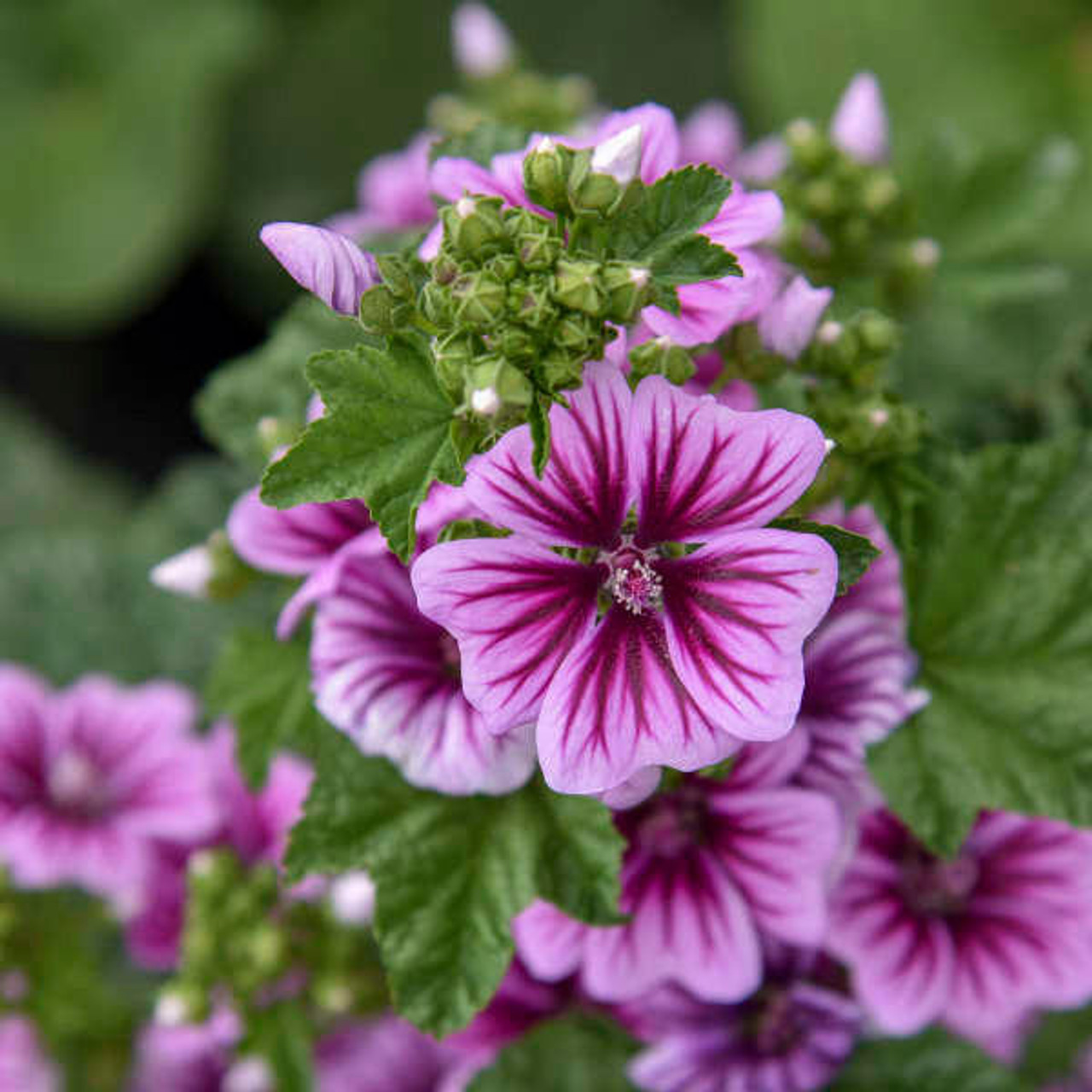Product Description
Malva sylvestris 'Zebrina' (30)ct Flat
Common Name: Mallow-Hollyhock, Zebra Mallow, Striped Mallow;
Family: Malvaceae
Erect, compact tough herbaceous perennial, 'Zebrina' sports soft pink flowers with raspberry-purple veins look like pinwheels. Two-inch, bowl-shaped flowers appear singly or in clusters from early summer to frost on robust, shrub-like plants. A short-lived perennial, Mallow self-seeds.
A shorter cousin of the Hollyhock, Striped Mallow is easily grown in average, medium, well-drained soil, with a moderate to high pH. Heat and drought tolerant, its one tough perennial!
Height: 24.0-48.0 Inches
Spread: 18.0-24.0 Inches
Hardiness Zones: 4,5,6,7,8
Flower Color: Pink shades
Foliage Color: Green shades
Full Sun (> 6 hrs. Direct Sun)
Low to Average Water Needs
Average to Fertile Soil Quality
Bloomtime: Early Summer - Mid Fall
Attracts Butterflies
Rabbit Resistant
Growth Rate: Medium
Border Plant, Cut Flower, Cut Foliage, Drought Tolerant, Mass Planting, Specimen, Focal Point
Malva sylvestris 'Zebrina' is a beautiful and eye-catching mallow cultivar that adds a touch of whimsy to gardens with their distinctive striped flowers. It is a vigorous grower and a prolific bloomer, making it a favorite among cottage gardeners and those seeking to attract pollinators. Here is a closer look at its charming features:
Appearance:
- Striped Flowers: 'Zebrina' produces lovely, 2-inch wide, cup-shaped flowers in a soft pink color adorned with deep raspberry-purple stripes. The flowers resemble miniature pinwheels and bloom profusely from mid-summer to fall.
- Attractive Foliage: The flowers are complemented by rounded, lobed, medium-green leaves.
- Upright Habit: This cultivar typically grows to about 2 to 4 feet tall and 18 to 24 inches wide, forming an upright clump.
Growing Conditions:
- Sunlight: Thrives in full sun (at least 6 hours of direct sunlight per day).
- Soil: Prefers well-drained soil. It is adaptable to various soil types and pH levels.
- Hardiness Zones: Suitable for USDA hardiness zones 5-9, making it a versatile choice for many gardeners.
Care:
- Low Maintenance: 'Zebrina' is a relatively low-maintenance plant.
- Watering: Water regularly, especially during dry periods, but avoid overwatering.
- Deadheading: Deadheading spent flowers can encourage additional blooms and prevent self-seeding.
- Staking: Taller plants may require staking to prevent them from flopping over, especially in windy conditions.
Uses:
- Cottage Gardens: Its cheerful colors and informal habit make it a perfect fit for cottage gardens.
- Borders: Adds a vertical element and a burst of color to borders and beds.
- Meadow Gardens: Creates a beautiful display when planted in groups in meadow gardens or naturalized areas.
- Cut Flowers: The long-lasting flowers are excellent for cutting and using in arrangements.
- Pollinator Gardens: The flowers attract butterflies, bees, and other pollinators.
Additional Information:
- Attracts Wildlife: The flowers attract pollinators, and the seeds provide food for birds.
- Deer and Rabbit Resistant: Deer and rabbits tend to avoid Malva.
- Self-Sowing: 'Zebrina' can self-sow, so you may find new seedlings popping up in the garden.
- Host Plant: It is a host plant for the Painted Lady butterfly.
If you are looking for a cheerful and easy-to-grow plant with beautiful striped flowers, Malva sylvestris 'Zebrina' is an excellent choice. Its vibrant colors and long bloom time will add beauty and life to any sunny garden.
Thirty (30) plants per flat (or tray). Approximate Plug Measurements: 3 inches deep x 2 inches wide.
Other Details
The most important part of the plant is its root system. Healthy roots are the foundation of a healthy, vibrant plant. The type of plug container used is based on the specific needs of the plants. Perennials offered as bare root traditionally perform better when planted as bare root.Planted in a specialized mix, potted plants have well established root systems. Top growth stage will vary depending on the current life cycle and time of year when shipped. In Winter and early Spring dormant plants may be shipped. Dormant plants may be planted right away, even before the last frost date.
Most bare root varieties are field grown for at least one season, though Hemerocallis and Hosta are grown for two seasons. The bulk of the soil is removed during the harvesting process and the tops of most varieties are trimmed back to the crown. They are graded, packed in shredded aspen or sphagnum moss and stored in freezers until ready to be shipped.
See our Container Sizes and Bare Root Perennials pages for more information.
Plant information and care is provided in the Overview section, Plant Genus Page and general information is provided in the Planting Care & Guides. Additional questions can be asked on each Plant page.
Plant Spacing: Using the maximum mature spread or width of a plant to guide spacing, ensures space to grow to full size. To fill an area sooner, plant them closer together. Just remember, future thinning or transplanting may be needed.
Water: Keep a close eye on newly planted perennials, especially throughout the first growing year. Most early plant loss is due to too much or too little water!











